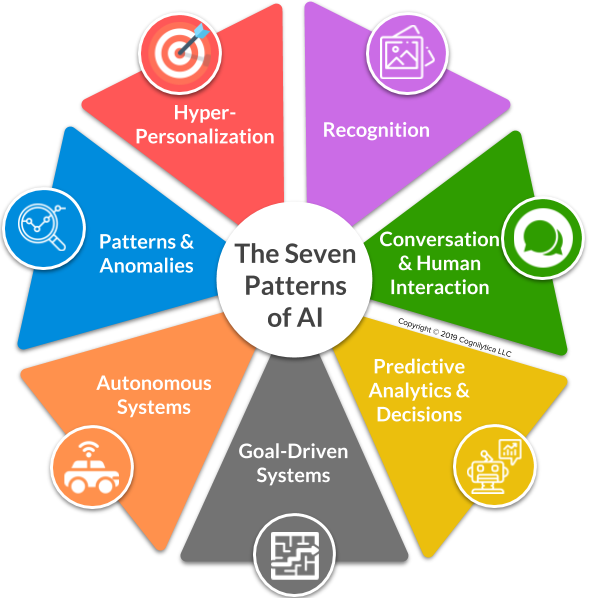Artificial intelligence and machine learning have become an increasingly important and central topic in recent years. The company Cognilytica has conducted an analysis from a classification matrix with over 3000 vendor companies in over 100 sub-segments of the AI market to analyze the most important building blocks of an AI application. The result was seven building blocks or patterns that all use cases, whether chatbot, image recognition software or autonomous vehicle, had in common. This article therefore takes a look at the seven structures of an artificial intelligence.
The seven AI building blocks

Hypersonalization
Hyperpersonalization is about using machine learning to develop a unique, individual profile that becomes more detailed and accurate over time. This profile can follow various tasks, such as displaying relevant content, recommending products or providing personal information.
The primary goal of hypersonalization is to look at each individual individually and not to fall into groupings or clusters. Machine learning is used here to meet the megatrend of personalization. Use cases include personalized content, personalized advice or recommendation systems.
Autonomous Systems
Autonomous systems are defined as systems that are capable of performing a task without the need for human involvement. This applies both to physical, hardware-autonomous systems and to software or virtual autonomous systems, so-called bots.
The primary goal of autonomous systems is to minimize human work and to facilitate the everyday life of users and providers. Examples of such systems can be found in chat bots, language assistants and systems that make independent decisions or where decisions requiring intelligence have to be made without human intervention.
Predictive Analytics & Decisions
The next of the seven building blocks is predictive analysis or, more simply, decision support. Here, artificial intelligence is used to interpret learned patterns and to support the prediction of future results. The goal of this building block is to support people in making decisions.
Such systems are used, for example, to predict behaviour, failures and trends. In this module, however, it is not the machine that makes the final decision, but only helps people to make their own decisions.
Conversation & Human Interaction
The conversation is about artificial intelligence interacting with humans. Whether through voice, text, images or written forms, this communication between machine and human should facilitate the exchange and strengthen the interaction between both groups.
This component also includes the creation of content, such as text, images, video and audio, for consumption by humans. The aim of this module is to interact with people in the same way as they would with each other. Examples can be found at Chatbots, but also language assistants like Alexa, Google Home or Siri.
Goal-Driven Systems
In the pattern & anomaly detection module, machine learning and other cognitive approaches are used for realization. The machines identify patterns in the data and look for connections that tell them whether there are outliers in the data or whether other anomalies deviate from the norm. The goal of anomaly detection is to distinguish between different phases and objects with increasing precision.
This type of AI is used in risk analysis or criminology, for example. It is also used in industry to identify anomalies in machines or in processes.
Recognition
The goal of recognition is to enable machines to identify and understand information in unstructured content. Image and object recognition, for example, is based on this principle. But face recognition, sound and audio recognition and the deciphering of handwriting and texts also belong to this component.
The more the artificial intelligence is trained, the better the success rates are and the better the AI is able to provide the right information.
Targeted systems
The final building block of artificial intelligence are the targeted systems. In simple terms, this is about learning from mistakes and constantly improving. Examples of goal-oriented systems can be found in the simulation of scenarios, in self-learning games and in resource optimization. In this module, the machines repeatedly test all conceivable variants and learn from successes and failures. This results in a continuous improvement of the system and the target-oriented orientation towards the goal.
Work with the patterns in the project
The modules defined above illustrate various possible uses in AI applications. Different goals and capabilities of artificial intelligence are defined. According to experience, each AI project can have one or more of the building blocks. The really successful applications usually combine the different parameters to enable really complex application scenarios. Before you start your own project, you should therefore identify which patterns you want to use.
For example, if you want to build a chatbot, you need both the conversation pattern, which optimizes human-machine interaction, and the autonomous system, since the idea behind the chatbot is to answer user questions independently of the human. This way you can proceed with each project and define your individual goals.

